I wrote a loop that made 10 graphs in R:
library(plotly)
for (i in 1:10)
{
d_i = data.frame(x = rnorm(100,100,100), y = rnorm(100,100,100))
title_i = paste0("title_",i)
p_i = plot_ly(data = d_i, x = ~x, y = ~y) %>% layout(title = title_i)
htmlwidgets::saveWidget(as_widget(p_i), paste0("plot_",i, ".html"))
}
I have this code (Input menu contents do not overflow row box in flexdashboard) that makes a dashboard in R:
---
title: "Test Dashboard"
output:
flexdashboard::flex_dashboard:
orientation: rows
vertical_layout: fill
runtime: shiny
---
```{r setup, include=FALSE}
library(flexdashboard)
library(shiny)
```
Column {data-width=100}
-----------------------------------------------------------------------
### Window 1
```{r}
selectInput("project", label = NULL, choices = c("A","B","C","D"))
```
Column {data-width=400}
-----------------------------------------------------------------------
### Chart B
```{r}
renderPlot({
plot(rnorm(1000), type = "l", main = paste("Project:",input$project, " Data:", input$data))
})
```
I would like to adapt this code so that the drop down menu allows the user to load the previously created graph/html file (e.g. from "My Documents") that is being searched for. For example, if the user searches for "plot_7", then plot_7 is displayed.
I tried the following code:
---
title: "Test Dashboard"
output:
flexdashboard::flex_dashboard:
orientation: rows
vertical_layout: fill
runtime: shiny
---
```{r setup, include=FALSE}
library(flexdashboard)
library(shiny)
```
Column {data-width=100}
-----------------------------------------------------------------------
### Window 1
```{r}
plots = rep("plot", 10)
i = seq(1:100)
choice = paste0(plots, "_",i)
selectInput("project", label = NULL, choices = choice)
```
Column {data-width=400}
-----------------------------------------------------------------------
### Chart B
```{r}
renderPlot({
<object class="one" type="text/html" data="plot_i.html"></object>
})
```
But this returns the following error:
Error: <text<:2:1 unexpected '<'
1: renderPlot({
2:<
^
Can someone please show me how I can fix this? And is it possible to do this WITHOUT shiny? (i.e. only in flexdashboard)
Thank you!





